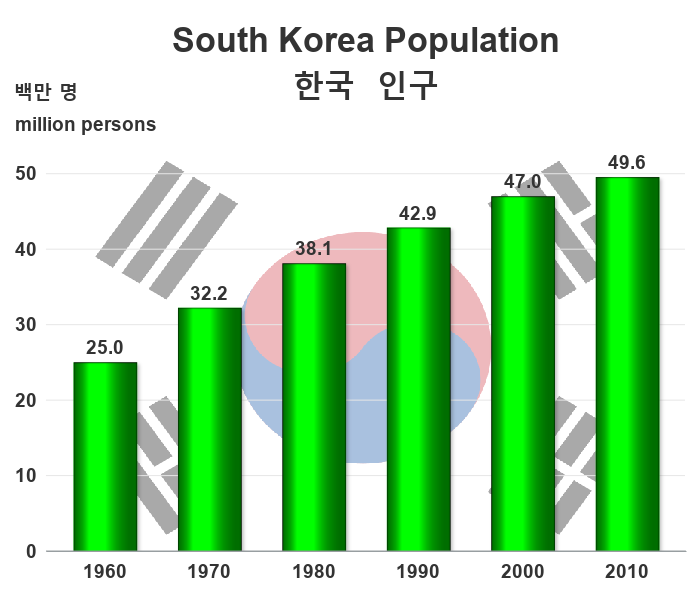When considering the population of the Korean Peninsula, one must examine two distinct nations: North Korea and South Korea. These neighboring states, albeit geographically close, diverge significantly in political structure, economic conditions, and indeed, demographic profiles. Understanding their populations provides a nuanced glimpse into the complexities of Korean identity, society, and the implications of their respective governance.
As of recent estimates, the population of South Korea stands at approximately 51 million individuals, while North Korea’s population hovers around 25 million. This stark contrast presents an intriguing juxtaposition, not only in numbers but also in the implications of those numbers for community, faith, and social wellbeing.
To explore the population dynamics further, one must first delve into the historical roots that have shaped the demographic landscapes of each nation. The partition of Korea in 1945, which was initially intended as a temporary division following World War II, formalized as a boundary through the Korean War (1950-1953), has left indelible scars on both territories. The separation fused political ideology with national identity, leading to divergent paths in economic development and societal values.
In South Korea, rapid industrialization, often termed the “Miracle on the Han River,” has dramatically surged the population rate and urbanization levels. The country has transformed from a largely agrarian society in the mid-20th century to an advanced technological powerhouse. The capital, Seoul, emerges as a bustling metropolis, drawing millions for economic opportunities. South Korea boasts high life expectancy rates and a burgeoning youth culture filled with innovation, creativity, and faith. Churches flourish across the nation, with a significant portion of the population identifying as Christian. This religious presence fosters a sense of community and collective purpose, impacting social policies and humanitarian efforts.
Contrastingly, North Korea’s population reflects the ramifications of isolationist policies and a totalitarian regime. The government’s strict control over every aspect of life has created a society where international engagement is minimal. The people often face challenges related to poverty, malnutrition, and limited access to healthcare and education. The North Korean government’s prioritization of military expenditures frequently eclipses basic human needs, leading to stark discrepancies in living standards compared to their southern counterparts.
This demographic disparity raises poignant questions regarding humanitarianism and ethical obligations from a Christian perspective. The doctrine of love, espoused in the teachings of Christ, compels believers to reflect on the plight of their neighbors, regardless of political boundaries. The commandment to care for those in need resonates deeply in a situation where millions struggle merely for sustenance and dignity.
The role of the Church in both nations illustrates a commitment to faith rooted in caring for others. In South Korea, vibrant communities often mobilize support for North Korean defectors, providing resources and assistance to help them navigate their complex transitions. Meanwhile, Christians in North Korea practice their faith in secrecy, enduring severe persecution. The resilience of these faithful souls serves as a testament to the human spirit, emphasizing the importance of hope and devotion even in the direst circumstances.
Understanding the sociopolitical context of both populations further contextualizes the faith-based responses to the challenges faced. In addition to the uplifting narratives, one must acknowledge the theological implications of division. The distinguishable presence of Christians in South Korea contrasts sharply with the pervasive atheism enforced by the North Korean regime. The policies of the north are antithetical to religious expression, where allegiance to the state supersedes any spiritual inclination. This dichotomy not only affects demographics but also impacts the spiritual landscape, with South Korean Christianity serving both as a unifying force and a source of division when contrasting beliefs are examined.
The population differences also evoke contemplations regarding reproduction and demographic sustainability. South Korea faces its own set of challenges, including declining birth rates that threaten to reshape its future. With a concerted societal focus on education and career success, families are choosing to have fewer children, creating the potential for an aging population. Conversely, in North Korea, despite facing dire living conditions, the birth rate remains relatively stable. However, the long-term effects of such demographics in a constricted environment are yet to be fully grasped.
In conclusion, the populations of North and South Korea embody more than mere statistics; they encapsulate the rich tapestry of human experience under vastly different conditions. The call to action for Christians is clear: fostering empathy and understanding transcends geographical boundaries. It implores believers to engage with the suffering of others, advocate for the vulnerable, and provide support wherever needed. The stark contrasts in population and welfare on the Korean Peninsula serve not only as a reminder of the varied expressions of human existence but also as an invitation to embody the principles of love and servitude inherent in the Christian faith. Ultimately, whether through prayer, advocacy, or tangible assistance, the brothers and sisters of Korea remain united in pursuit of dignity, hope, and faith amidst adversity.



